Establishing a consistent feeding schedule for your dog is key for your pet’s happiness and health. However, it can be challenging to select an appropriate schedule for your canine companion with so much conflicting advice out there.
Don’t worry — we’ll pierce through the noise and share some tips for crafting the ideal feeding schedule for your dog. We’ll also share some general tips for instilling healthy eating habits in your hound.
How to Create a Feeding Schedule for Dogs: Key Takeaways
- Even though dogs are often willing to eat whenever food is offered, it is important to establish a consistent feeding schedule. This not only helps ensure they don’t get famished during the day, but it provides the kind of consistency canines crave.
- The exact schedule you adopt will vary based on myriad factors, but adult and senior dogs need to eat twice each day, about 12 hours apart. Puppies, thanks to their rapid-fire metabolisms, need to eat thrice daily, about 8 hours apart.
- You’ll want to consider your daily schedule when adopting a feeding schedule. For example, if you leave the house every morning around 8:00 AM, it may be wise to schedule “breakfast” for about 7:00 AM.
The Importance of a Consistent Feeding Schedule for Dogs

While your dog probably won’t “suffer” or experience any serious health problems from eating at haphazard times, implementing a consistent feeding schedule will provide a number of benefits for you and your pupperino.
A few of the most noteworthy benefits consistent feeding schedules provide include:
- Feeding schedules provide consistency for canines. Dogs are creatures of habit, and they crave consistency. Creating a regular feeding schedule provides a form of security and also gives your four-footer something to look forward to!
- Consistent feeding schedules ensure that our furry friends are given enough time to digest their previous meal. This not only helps ensure food passes through your dog’s digestive system smoothly, it also gives your dog time to work up an appetite before consuming another meal.
- Consistent canine feeding schedules can help regulate your dog’s elimination schedule. Let’s face it: It’s nice to know when your dog is gonna poop next – it just makes planning your day easier. And by feeding your dog at consistent times, you can help him develop a relatively consistent pooping schedule.
- Consistent feeding schedules can help streamline your daily dog-care duties. Feeding time can also be scheduled to coincide with other activities. For instance, you might take Fido out for his morning walk before breakfast.
- Feeding your pup at regularly scheduled times makes it easier to detect health problems. If your dog is suddenly disinterested in dinner at his normal feeding time, it may be time to make a visit to the veterinarian. But if you aren’t feeding him at the same time every day, you may just assume he isn’t hungry yet.
- Consistent feeding schedules can make it easier for pups to cope with lifestyle changes. For example, if you’re moving or introducing a new family member to the house, consistent meal times will likely give your pet a bit of comfort and predictability.
All in all, creating a consistent feeding schedule makes it easier to care for your canine and provide your pooch with the nutrition he needs.
How to Create a Feeding Schedule for Dogs
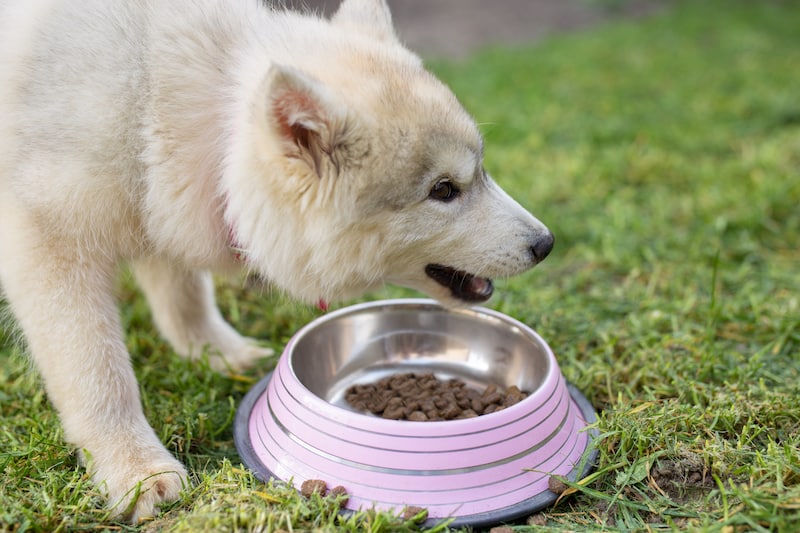
There’s a lot that goes into creating an ideal feeding schedule for your furry friend. But by answering a few easy questions, you’ll find that a schedule more-or-less “emerges” from your answers.
Below, we’ll share some of the questions to consider when scheduling your mutt’s mealtimes.
How much food does your dog need each day?
The first thing you’ll have to think about when implementing a dog feeding schedule is the amount of food your dog needs on a daily basis. Once you’ve determined this figure (in terms of calories or cups of food), you can divide it in two or three, depending on the number of meals you plan to offer each day.
The amount of food you should feed your dog depends on a daily basis depends on a wide variety of factors. Your dog’s lifestyle, age, and even breed can help determine what your dog’s daily eating habits look like. You’ll also want to collaborate with your veterinarian to find the ideal amount of food for your dog’s specific needs.
That being said, you can determine a ballpark figure by utilizing this tried and true formula from veterinarians. You can also seek out a calorie by weight chart from a high-quality source like WSAVA.
Dog food manufacturers also print feeding recommendations on food labels which can give you a general idea of how much your pooch should be eating.
Don’t forget: Treats and snacks (like that bit of pizza crust you just have to give Fido) count towards his overall daily calorie count!
How many times a day should your dog eat?
After figuring out the quantity of food your dog needs each day, you’ll need to decide how often you need to feed him.
Most adult dogs should eat about two times a day, with about 8 to 12 hours between feedings. However, there’s nothing wrong with feeding your adult doggo three times a day if you prefer (and that may be helpful with dogs who wolf down their food super quickly).
On the other hand, puppies need to eat slightly more often, about 3 times a day since they burn through calories much faster. Several small meals may also help cut back on bilious vomiting syndrome, canine bloat, and other gastrointestinal issues.
Senior pups can be fed twice a day just like adult dogs, but it’s worth noting that golden oldies have specialized nutritional needs, so it’s always wise to select one of the best foods for senior dogs. Older dogs are also known to be somewhat picky, so you might end up adding a tasty dog food topper to your dog’s diet.
What time of day should your dog eat?
So, now you now your dog needs X calories per day and you want to feed him X number of times a day. With this information in mind, you can try to figure out the exact times of day you’ll feed him each meal.
In the broadest sense, you’ll essentially want to feed your dog sometime in the morning and again in the afternoon or evening (puppies also need to eat at midday).
For example, you may decide that “breakfast” is served at 8:00 AM and “dinner” happens at about 6:00 PM (and if you have a puppy, he’d need “lunch” around 1:00 PM).
But as long as you’re consistent, you can schedule your dog’s meal times around your family’s schedule.
It’s easy to pick consistent feeding times for the work week, but don’t forget to consider how your typical weekend plans will work with your dog’s feeding schedule. If you generally like to sleep in on the weekends, you should probably avoid scheduling breakfast for 6:00 AM.
For that matter, give some thought to unusual things like vacations too.
Where should you feed your dog?
We’re primarily focusing on the time at which you should feed your dog, but it’s also important to consider where to set the table, so to speak.
For the most part, you can select anywhere you like, as long as it is a clean, dry place that he can easily access. The kitchen floor is likely the most common place owners feed Fido, but laundry rooms, dining rooms, and porches work better for others.
There is one caveat to that: Try to avoid placing his feeding location too close to the dinner table or where you prepare food. This way, you won’t have to face your pup’s prying eyes when you’re having steak and he’s working with kibble.
In some cases, it might be wise to have your dog’s food and water station near his crate or bedding area which can help create a positive association with your dog’s den.
Just make sure that your area of choice is easy to clean and accessible for your canine companion.
Why Shouldn’t I Just Leave Food Out All the Time?
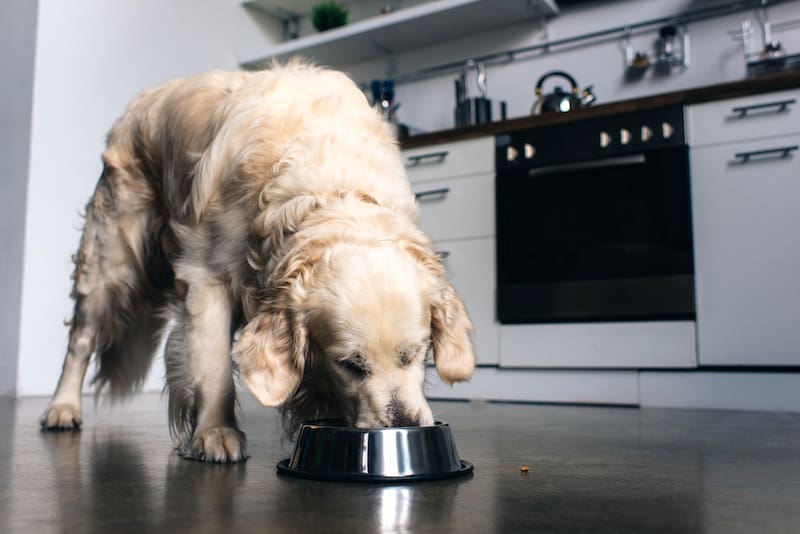
Some owners like to simply pour a bunch of food in a bowl, leave it sitting out, and then refill it as necessary. This way, Spot can just chow down when he wants to.
This type of feeding approach — known as ad libitum feeding — works for some owners and their pets, but there are a few reasons it is generally best to stick to feeding individual, scheduled meals:
- While some dogs are able to regulate their food intake fairly well on their own, work in a few select cases, it causes other dogs to consume more calories than they should.
- Leaving food out all day (and night) is like ringing the dinner bell for bugs — you don’t want that.
- Many owners tend to neglect proper dish-washing when they leave food out at all times.
- It is harder to monitor the amount of food your dog eats, which may make it harder to notice changes in appetite (which can signal health problems).
- It presents serious problems in multi-pet households, as pets may steal the food intended for their roommates.
If you want to try out a “grazing” approach for your canine companion, just be sure to measure out your dog’s food for the day. At least this way, you’ll know that he has access to the appropriate amount of food.
What Kinds of Other Things Should You Do at Feeding Time?
In addition to giving your dog the correct amount of food, at the appropriate times, and in a sensible location, you want to keep a few other things in mind at mealtimes.
For example, it’s a good idea to keep an eye on your pooch while he’s chowing down.
Any dog, but especially enthusiastic eaters, may choke while eating. If you’re monitoring the situation, you’ll be able to intervene and implement the doggie Heimlich maneuver if necessary. While the risk is fairly minimal, it’s still worth being close by while your furry friend enjoys his meal.
But be careful that you don’t distract your dog while he’s eating by interacting with him in any way. Even a friendly pat on the haunches could be interpreted as a potential threat by your pup. Make sure everyone in your household understands this as well, particularly young children.
Finally, if you have more than one pet, it’s a good idea to serve each furry friend in a separate area. After your dogs are finished eating, clean the food bowl and sweep up any stray crumbs.
Additional Dog Feeding Tips
Here are a couple of additional feeding tips to keep in mind during your mutt’s mealtime:
- Always measure the amount of food given. It’s essential to measure out your dog’s food to ensure that he’s getting the appropriate number of calories. This can help prevent obesity and give you the confidence that your dog has had enough even when he gives you those irresistible puppy eyes. Just pick up a measuring cup and store it with your dog’s food to make things easier.
- Factor in treats and people food. Your dog’s treats and any dog-safe people food should be factored into your dog’s daily calorie calculation.
- Clean dishes regularly. Make a habit of cleaning your dog’s dishes at least once a day, if not after every use. Most food and water bowls (including stainless steel dog bowls) are safe to throw in the dishwasher, so this isn’t a big chore or anything. Also, be sure to toss out any uneaten food after it’s been sitting out for an hour or so.
- Use a good dog food storage container. Keep Fido’s food fresh by using an airtight container (don’t forget wet food leftovers must be refrigerated). This will help keep your canine’s kibbles tasty and free of bacteria and pests.
- Consider using a puzzle feeder. If your dog wolfs down his meals without abandon, it’s worth considering a puzzle feeder. These tools can help slow down Spot’s eating and engage his brain simultaneously.
***
Having a consistent feeding schedule is a great way to keep your hound healthy. It also makes it easier for pet parents to notice when something is off, which is invaluable in its own right.
Does your dog have a set routine? Does he look forward to dinner time? We’d love to hear all about it in the comments below!


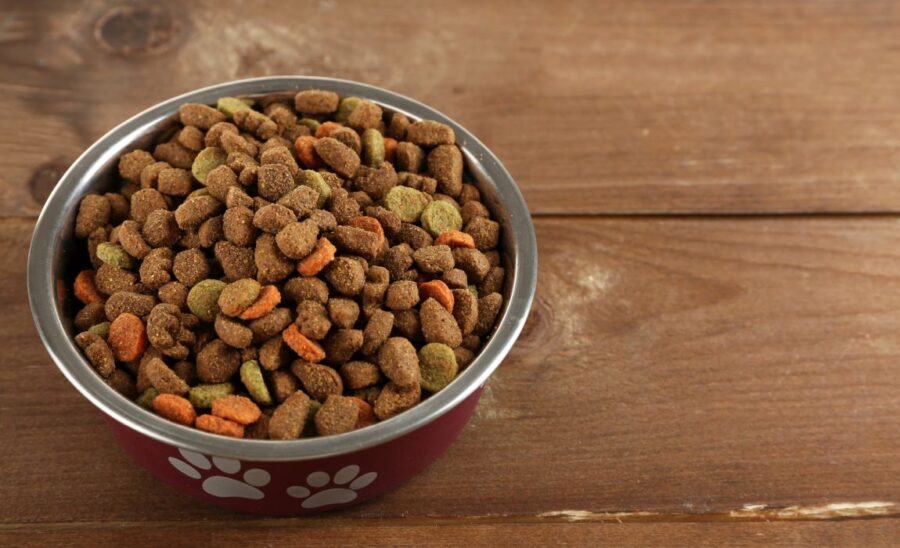


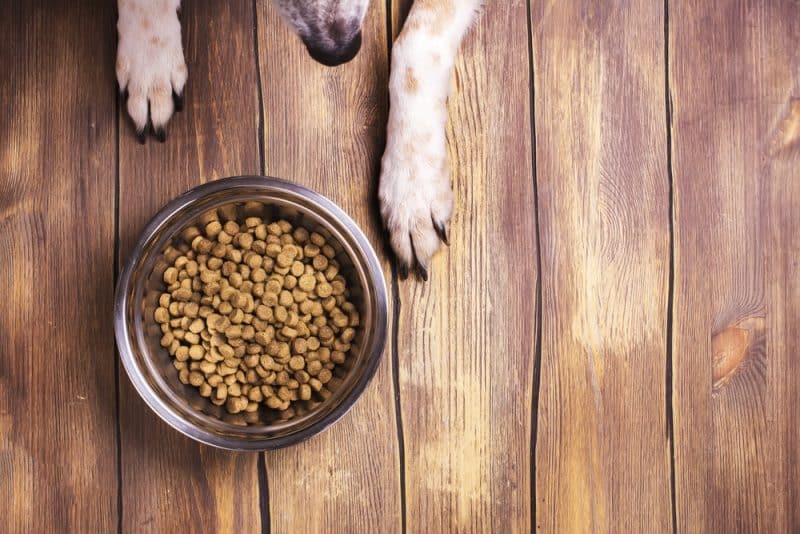
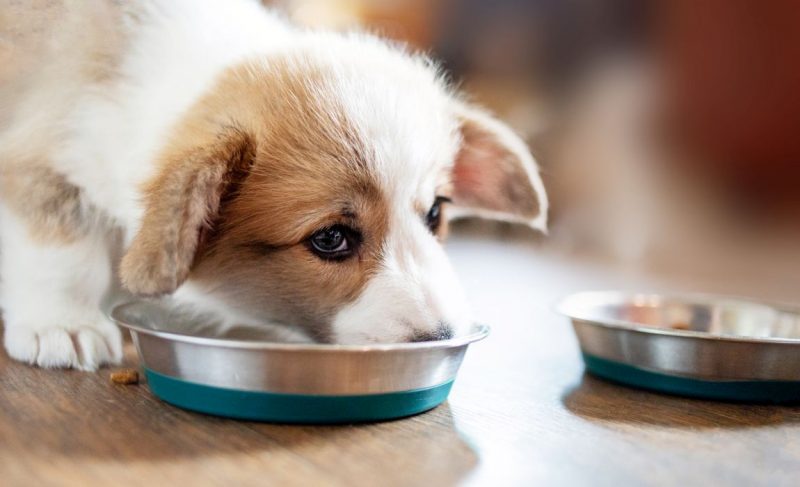
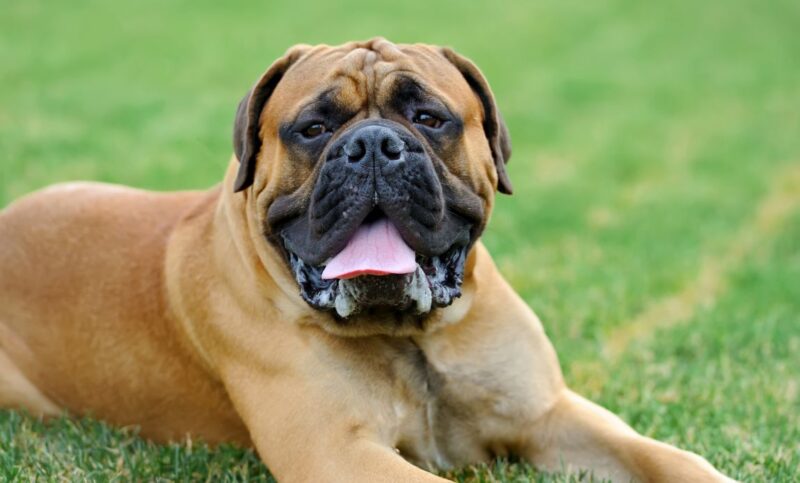
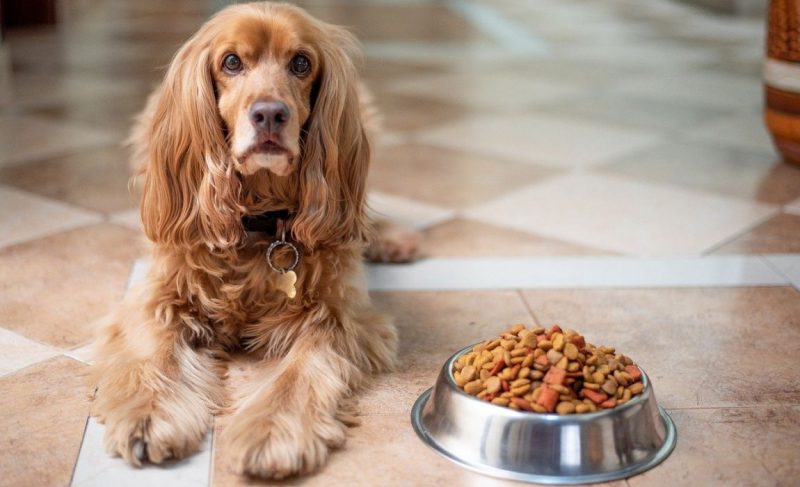
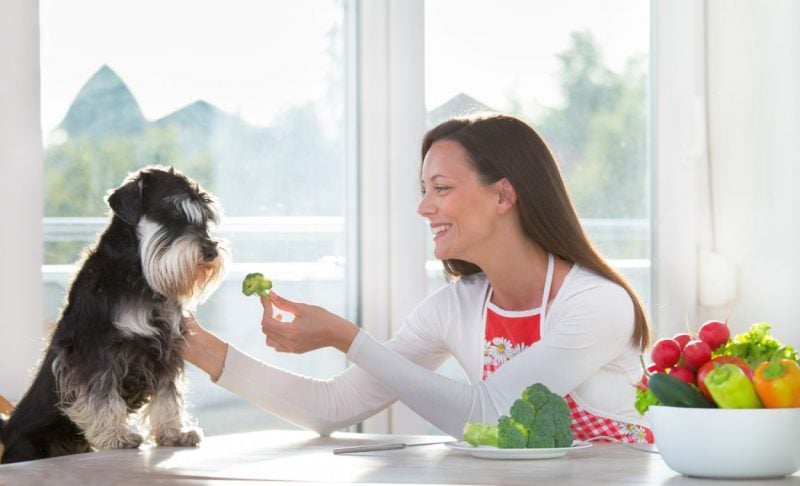
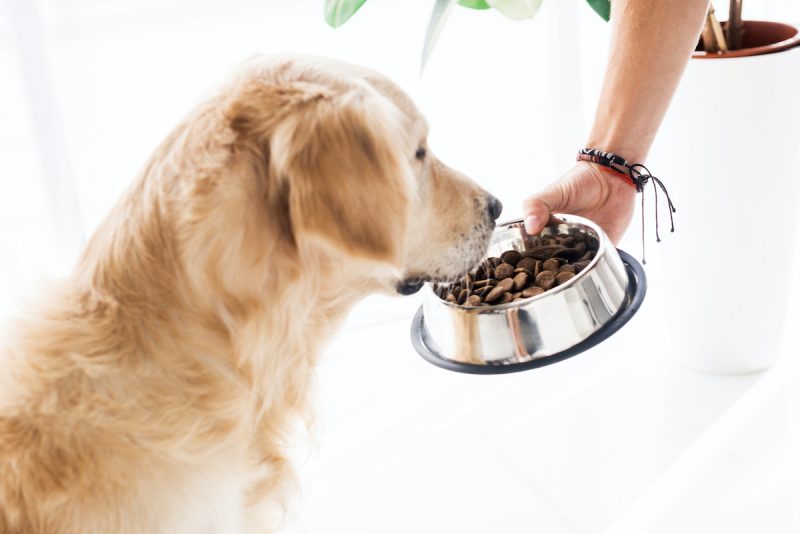
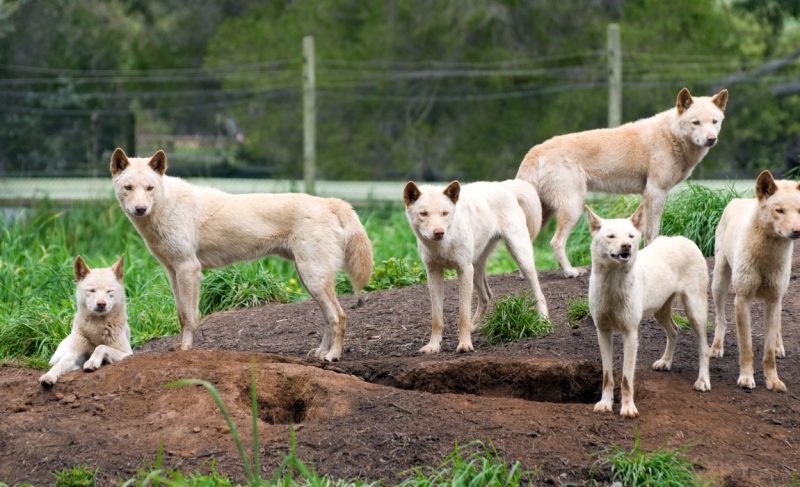

Leave a Comment